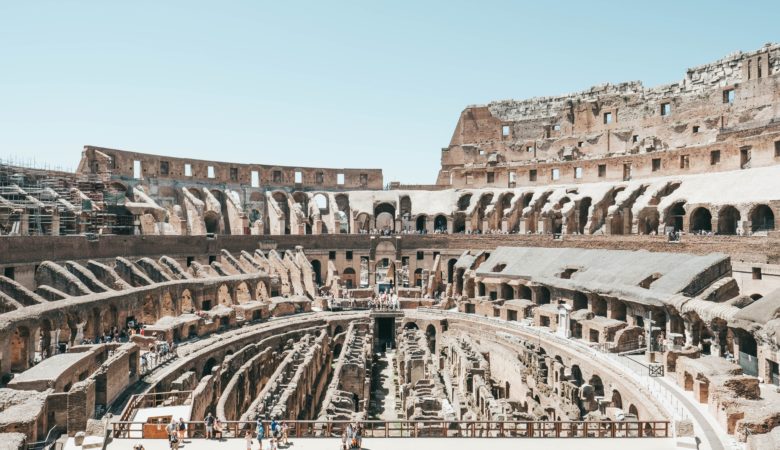Do You Know the 7 Ancient Wonders of the World?

“The seven ancient wonders of the world” is a phrase that gets tossed around a lot. And while you might know what it means colloquially—impressive human buildings or inventions that are like none other on earth—do you know what they actually were, and which ones still exist to this day? Moreover, you might be surprised to hear that there are generally accepted wonders of the modern world as well. Whether you’re looking for vacation ideas or just have Jeopardy! champion aspirations, here are the seven ancient and modern wonders of the world.
Ancient wonders that still capture modern interest
- Great Pyramid of Giza. The Great Pyramid of Giza is the only surviving wonder of the ancient world, built between 2700-2500 BCE as royal tombs. The pyramid spans an incredible 13 acres and contains over two million stone blocks, most of which weigh between two to 30 tons each. How it was built is still a mystery.
- Hanging gardens of Babylon. The hanging gardens of Babylon might not have been a real ancient wonder at all—although there are contemporaneous accounts in Greek and Roman texts, there are none in Babylonian inscriptions. The legend goes that King Nebuchadnezzar II built them for his homesick lover. If they were real, the necessary irrigation system would have been impressive indeed.
- Colossus of Rhodes. In the 3rd century BCE, Rhodians built a hundred-foot tall statue of Helios, the sun god, which was toppled by an earthquake in 220 BCE. Eventually, invaders seized the statue to sell for scrap metal.
- Temple of Artemis at Ephesus. In 550 BCE, the most famous temple of Artemis was built at Ephesus (modern-day Turkey). The temple, which was reputed to be the grandest one in the ancient world, burned around 350 BCE. Remains of the rebuilt temple have been unearthed in modern times.
- Lighthouse at Alexandria. Around 270 BCE, Egyptians built a lighthouse on the Nile River—modern scholars estimate that it was about 380 feet tall, and coins have been found depicting its three-tier structure. Some remains have been found in the Nile after it was destroyed by multiple earthquakes.
- Statue of Zeus at Olympia. Zeus was the most important of the Greek gods, and this ancient 40-foot statue was a tribute to his awesome power. Eventually it was moved to Constantinople and destroyed in a fire around 462.
- Mausoleum at Halicarnassus. Finally, the mausoleum at Halicarnassus was built by Artemisia to commemorate her husband, the king of Carnia, after he died in 353 BCE. The massive, 135-foot-tall structure was destroyed by an earthquake in the 13th century, but relics from the mausoleum have been discovered and are currently at the British Museum.
Humanity’s greatest modern wonders
If all these lost wonders make your inner history nerd sad, there are seven modern wonders that you can visit today.
- The Taj Mahal. This mausoleum, built by Mughal Emperor Shah Jahan for his beloved wife between 1632 and 1648, is a popular tourist attraction thanks to its stunning white marble architecture.
- Petra, Jordan. This indoor oasis was built in the Nabataean empire of King Aretas IV, and probably lasted about 50-60 years in its prime, which was around 9 BCE to CE 40. In addition to water tunnels and chambers, it also boasted an amphitheater and a monastery.
- The Great Wall of China. The Great Wall of China was built over centuries, ending in the 16th century CE. It spans over 4,000 miles and is the longest man-made structure in the world.
- Christ the Redeemer statue in Rio de Janeiro. This iconic statue was erected in 1931 and is one of the most famous symbols of Brazil, and specifically Rio de Janeiro. It stands 130 feet tall and is made of soapstone.
- Machu Picchu. Machu Picchu is nestled in the Andean mountains and was built by Incan tribes in 15th century CE. It remained “undiscovered” in modern memory until 1911, when it was rediscovered by an archeologist.
- Chichen Itza in Mexico. Located on the Yucatan Peninsula, Chichen Itza is a Mayan city that was thought to be in its prime from 800 to 1200 CE.
- The Colosseum in Rome. Finally, the Colosseum ruins (home to famed gladiator battles) in Rome are a grand example of ancient architecture that, to this day, draws millions of visitors.
Whether ancient or modern, these marvels are a testament to human capability and the grandeur of creation. From massive statues to palaces and ruins, each is truly a sight to behold. What do you think the next seven wonders will be when someone 1000 years from now looks back?

